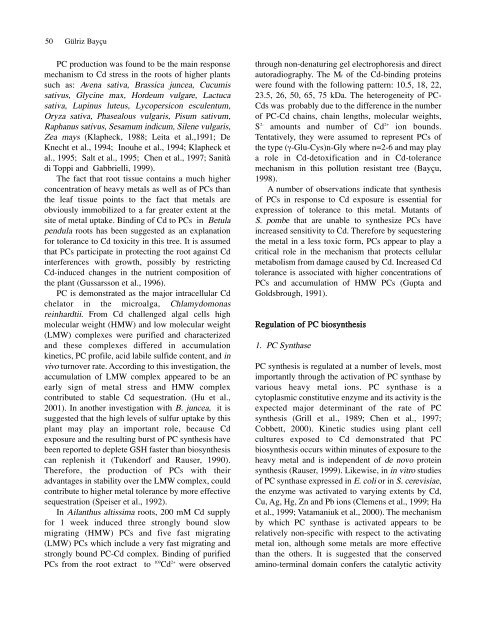Full Journal - Journal of Cell and Molecular Biology - Haliç Üniversitesi
Full Journal - Journal of Cell and Molecular Biology - Haliç Üniversitesi
Full Journal - Journal of Cell and Molecular Biology - Haliç Üniversitesi
Create successful ePaper yourself
Turn your PDF publications into a flip-book with our unique Google optimized e-Paper software.
50 Gülriz Bayçu<br />
PC production was found to be the main response<br />
mechanism to Cd stress in the roots <strong>of</strong> higher plants<br />
such as: Avena sativa, Brassica juncea, Cucumis<br />
sativus, Glycine max, Hordeum vulgare, Lactuca<br />
sativa, Lupinus luteus, Lycopersicon esculentum,<br />
Oryza sativa, Phasealous vulgaris, Pisum sativum,<br />
Raphanus sativus, Sesamum indicum, Silene vulgaris,<br />
Zea mays (Klapheck, 1988; Leita et al.,1991; De<br />
Knecht et al., 1994; Inouhe et al., 1994; Klapheck et<br />
al., 1995; Salt et al., 1995; Chen et al., 1997; Sanità<br />
di Toppi <strong>and</strong> Gabbrielli, 1999).<br />
The fact that root tissue contains a much higher<br />
concentration <strong>of</strong> heavy metals as well as <strong>of</strong> PCs than<br />
the leaf tissue points to the fact that metals are<br />
obviously immobilized to a far greater extent at the<br />
site <strong>of</strong> metal uptake. Binding <strong>of</strong> Cd to PCs in Betula<br />
pendula roots has been suggested as an explanation<br />
for tolerance to Cd toxicity in this tree. It is assumed<br />
that PCs participate in protecting the root against Cd<br />
interferences with growth, possibly by restricting<br />
Cd-induced changes in the nutrient composition <strong>of</strong><br />
the plant (Gussarsson et al., 1996).<br />
PC is demonstrated as the major intracellular Cd<br />
chelator in the microalga, Chlamydomonas<br />
reinhardtii. From Cd challenged algal cells high<br />
molecular weight (HMW) <strong>and</strong> low molecular weight<br />
(LMW) complexes were purified <strong>and</strong> characterized<br />
<strong>and</strong> these complexes differed in accumulation<br />
kinetics, PC pr<strong>of</strong>ile, acid labile sulfide content, <strong>and</strong> in<br />
vivo turnover rate. According to this investigation, the<br />
accumulation <strong>of</strong> LMW complex appeared to be an<br />
early sign <strong>of</strong> metal stress <strong>and</strong> HMW complex<br />
contributed to stable Cd sequestration. (Hu et al.,<br />
2001). In another investigation with B. juncea, it is<br />
suggested that the high levels <strong>of</strong> sulfur uptake by this<br />
plant may play an important role, because Cd<br />
exposure <strong>and</strong> the resulting burst <strong>of</strong> PC synthesis have<br />
been reported to deplete GSH faster than biosynthesis<br />
can replenish it (Tukendorf <strong>and</strong> Rauser, 1990).<br />
Therefore, the production <strong>of</strong> PCs with their<br />
advantages in stability over the LMW complex, could<br />
contribute to higher metal tolerance by more effective<br />
sequestration (Speiser et al., 1992).<br />
In Ailanthus altissima roots, 200 mM Cd supply<br />
for 1 week induced three strongly bound slow<br />
migrating (HMW) PCs <strong>and</strong> five fast migrating<br />
(LMW) PCs which include a very fast migrating <strong>and</strong><br />
strongly bound PC-Cd complex. Binding <strong>of</strong> purified<br />
PCs from the root extract to 109 Cd 2+ were observed<br />
through non-denaturing gel electrophoresis <strong>and</strong> direct<br />
autoradiography. The Mr <strong>of</strong> the Cd-binding proteins<br />
were found with the following pattern: 10.5, 18, 22,<br />
23.5, 26, 50, 65, 75 kDa. The heterogeneity <strong>of</strong> PC-<br />
Cds was probably due to the difference in the number<br />
<strong>of</strong> PC-Cd chains, chain lengths, molecular weights,<br />
S 2- amounts <strong>and</strong> number <strong>of</strong> Cd 2+ ion bounds.<br />
Tentatively, they were assumed to represent PCs <strong>of</strong><br />
the type (γ-Glu-Cys)n-Gly where n=2-6 <strong>and</strong> may play<br />
a role in Cd-detoxification <strong>and</strong> in Cd-tolerance<br />
mechanism in this pollution resistant tree (Bayçu,<br />
1998).<br />
A number <strong>of</strong> observations indicate that synthesis<br />
<strong>of</strong> PCs in response to Cd exposure is essential for<br />
expression <strong>of</strong> tolerance to this metal. Mutants <strong>of</strong><br />
S. pombe that are unable to synthesize PCs have<br />
increased sensitivity to Cd. Therefore by sequestering<br />
the metal in a less toxic form, PCs appear to play a<br />
critical role in the mechanism that protects cellular<br />
metabolism from damage caused by Cd. Increased Cd<br />
tolerance is associated with higher concentrations <strong>of</strong><br />
PCs <strong>and</strong> accumulation <strong>of</strong> HMW PCs (Gupta <strong>and</strong><br />
Goldsbrough, 1991).<br />
Regulation <strong>of</strong> PC biosynthesis<br />
1. PC Synthase<br />
PC synthesis is regulated at a number <strong>of</strong> levels, most<br />
importantly through the activation <strong>of</strong> PC synthase by<br />
various heavy metal ions. PC synthase is a<br />
cytoplasmic constitutive enzyme <strong>and</strong> its activity is the<br />
expected major determinant <strong>of</strong> the rate <strong>of</strong> PC<br />
synthesis (Grill et al., 1989; Chen et al., 1997;<br />
Cobbett, 2000). Kinetic studies using plant cell<br />
cultures exposed to Cd demonstrated that PC<br />
biosynthesis occurs within minutes <strong>of</strong> exposure to the<br />
heavy metal <strong>and</strong> is independent <strong>of</strong> de novo protein<br />
synthesis (Rauser, 1999). Likewise, in in vitro studies<br />
<strong>of</strong> PC synthase expressed in E. coli or in S. cerevisiae,<br />
the enzyme was activated to varying extents by Cd,<br />
Cu, Ag, Hg, Zn <strong>and</strong> Pb ions (Clemens et al., 1999; Ha<br />
et al., 1999; Vatamaniuk et al., 2000). The mechanism<br />
by which PC synthase is activated appears to be<br />
relatively non-specific with respect to the activating<br />
metal ion, although some metals are more effective<br />
than the others. It is suggested that the conserved<br />
amino-terminal domain confers the catalytic activity

















